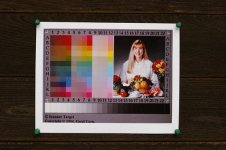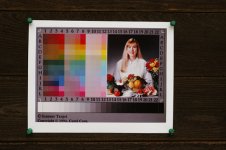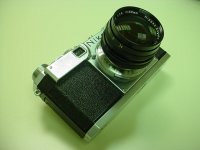Ed Schwartzreic
Well-known
With the loan of a 50/1.4 Summilux aspheric from one of our members, I have finished and uploaded a detailed comparison of thse two lenses, as promised. I hope you enjoy it and are perhaps surprized by the outcome.
Ed
link here: http://www.imagere.com/edsarticles/fast50shootout.htm
Ed
link here: http://www.imagere.com/edsarticles/fast50shootout.htm
NIKON KIU
Did you say Nippon Kogaku
Wow,
Thanks Ed, for posting this up....very very interesting!
Comparing the two enlargments of the yellow can, Leica center at f/2.8 and Nikkor center at f/2.8 I couldn't help but realize that the Nikkor had a much better color rendition than the Leica. Do you feel the same way?
Thanks again,
Kiu
Thanks Ed, for posting this up....very very interesting!
Comparing the two enlargments of the yellow can, Leica center at f/2.8 and Nikkor center at f/2.8 I couldn't help but realize that the Nikkor had a much better color rendition than the Leica. Do you feel the same way?
Thanks again,
Kiu
Ed Schwartzreic
Well-known
All 3 of the Nikkor shots of the yellow can look similar to me, and as you point out, they are different form the rendition of yellow from the Summilux. Holding the actual can next to the monitor (perhaps a dubious procedure here in the reddish light of early evening here), the actual color of the can appears to fall between the two lenses' renditions! The Nikkor rendition has less magenta in it. This is a tough one. I'd like to see slide film on the appropriate lightbox.
Ed
Ed
BillBingham2
Registered User
Ed,
Thank you sir, this was way cool.
B2 (;->
Thank you sir, this was way cool.
B2 (;->
Ed Schwartzreic
Well-known
Herre is further material in answer to Kiu's question. I shot a color target with both lenses, and am posting them here. The target is not an original, but rather a copy; therefore if you own this target, DO NOT compare these images directly with it, but rather with each other. The fiirst image is from the Summilux, the second from the Nikkor.
Ed
Ed
Attachments
VinceC
Veteran
Thanks for posting this. I think I'm surprised, or at least intrigued. I've been using the Millenneum lens for about six months now and could immediately see the difference compared to the older Nikkor classic from the 1950s.
The impression I've had, without any side-by-side tests, is that the Millenneum lens has a signature -- in edge-to-edge sharpness, detail and out-of-focus qualities -- quite similar to the Auto-Nikkor 50mm SLR lens of the 1960s. This leads me to suspect that it is a multicoated version of the fabled "Olympic" lens of the early 1960s. That's why I was surprised, because the lens more than holds its own against what I imagine is the finest, most modern 50/1.4 Leitz lens to date.
I purchased my used 1960s 50mm SLR Auto-Nikkor 25 years ago along with a Nikomat FTn, back in an era when nobody talked about Bokeh. I was doing photojournlism-type work for the U.S. Army and also using a Pentax and Canons at the time. I immediately fell in love with the 50mm Auto-Nikkor and used the Nikomat as my "50mm lens camera" from then on out. A few years later, I had a daily newspaper job and started buying and using vintage Nikon rangefinders -- at the time, they were considerably cheaper than Leicas, a situation that has since changed -- and found the classic 50mm Nikkor from the 1950s to be an excellent but quirky lens, not quite up to the standards of my 50/1.4 SLR lens. It could flare badly, could be too contrasty in harsh light, and had weird out-of-focus characteristics.
My impression, from years of shooting the SLR version of the lens, was that it had wonderful qualities with no real need for improvement under the conditions in which I jused it. Long before I ever heard the term Bokeh, I knew it had beautiful out-of-focus characteristics, useful for portraiture, and no discernible lack of sharpness (not always useful for portraiture). I have two copies of the lens, both from the late 1960s, so it's not a situation where I have a rare perfect Nikkor. Yet I've spent decades with Leica users talking about the inferiority of Nikkor SLR lenses and the Auto-Nikkor 50mm F-mount lens in particular, compared to Leitz alternatives. I've always taken this for granted. As a photojournalist, I figured I never needed the last Angstrom of sharpness, because all reproduced photos get turned into dots anyway as part of the printing process. My lenses -- most of them purchased in pawnshops outside military bases -- worked well enough for me. I assumed switching to Leitz glass would mean switching from Excellence to Perfection, and I had no practical need to make such a switch.
That's why these test really surprise me. The 40-plus year old Nikkor design, with the addition of multicoating, is fully comparable to the latest possible Leitz computer-aided floating element design. Even if it's the Nikon design from the 1990s, reworked for an RF, its still comparable to Leitz.
It's true, the SLR and RF formulae can't be identical. Comparing my Millenneum to an Auto-Nikkor, the Millenneum sits considerably closer to the film plane whereas the mount of the Auto-Nikkor sits about 1.5cm further from the film plane in order to clear the SLR mirror box. The front elements appear identical. But the rear element of the Millenneum has a smaller diameter ... it is as large as physically possible due to the size restriction of the Nikon RF mount, whereas the SLR F-mount is considerably larger. The rear elements of both the Auto-Nikkor and Millenneum Nikkor appear to be perfectly flat, unlike the Sonnar-derived classic 50 Nikkor of the 1950s, which has a rounded rear element.
The shape of the Millenneum is identical to the shape of the Nikkor "Olympic" from the early 1960s. This was Nikon's redesigned 50mm lens sold during the 1960s with new-old-stock rangefinder cameras, particularly the black special edition S3s released about 1963-64.
Again, thanks for doing the test, and thanks very much for posting the results.
The impression I've had, without any side-by-side tests, is that the Millenneum lens has a signature -- in edge-to-edge sharpness, detail and out-of-focus qualities -- quite similar to the Auto-Nikkor 50mm SLR lens of the 1960s. This leads me to suspect that it is a multicoated version of the fabled "Olympic" lens of the early 1960s. That's why I was surprised, because the lens more than holds its own against what I imagine is the finest, most modern 50/1.4 Leitz lens to date.
I purchased my used 1960s 50mm SLR Auto-Nikkor 25 years ago along with a Nikomat FTn, back in an era when nobody talked about Bokeh. I was doing photojournlism-type work for the U.S. Army and also using a Pentax and Canons at the time. I immediately fell in love with the 50mm Auto-Nikkor and used the Nikomat as my "50mm lens camera" from then on out. A few years later, I had a daily newspaper job and started buying and using vintage Nikon rangefinders -- at the time, they were considerably cheaper than Leicas, a situation that has since changed -- and found the classic 50mm Nikkor from the 1950s to be an excellent but quirky lens, not quite up to the standards of my 50/1.4 SLR lens. It could flare badly, could be too contrasty in harsh light, and had weird out-of-focus characteristics.
My impression, from years of shooting the SLR version of the lens, was that it had wonderful qualities with no real need for improvement under the conditions in which I jused it. Long before I ever heard the term Bokeh, I knew it had beautiful out-of-focus characteristics, useful for portraiture, and no discernible lack of sharpness (not always useful for portraiture). I have two copies of the lens, both from the late 1960s, so it's not a situation where I have a rare perfect Nikkor. Yet I've spent decades with Leica users talking about the inferiority of Nikkor SLR lenses and the Auto-Nikkor 50mm F-mount lens in particular, compared to Leitz alternatives. I've always taken this for granted. As a photojournalist, I figured I never needed the last Angstrom of sharpness, because all reproduced photos get turned into dots anyway as part of the printing process. My lenses -- most of them purchased in pawnshops outside military bases -- worked well enough for me. I assumed switching to Leitz glass would mean switching from Excellence to Perfection, and I had no practical need to make such a switch.
That's why these test really surprise me. The 40-plus year old Nikkor design, with the addition of multicoating, is fully comparable to the latest possible Leitz computer-aided floating element design. Even if it's the Nikon design from the 1990s, reworked for an RF, its still comparable to Leitz.
It's true, the SLR and RF formulae can't be identical. Comparing my Millenneum to an Auto-Nikkor, the Millenneum sits considerably closer to the film plane whereas the mount of the Auto-Nikkor sits about 1.5cm further from the film plane in order to clear the SLR mirror box. The front elements appear identical. But the rear element of the Millenneum has a smaller diameter ... it is as large as physically possible due to the size restriction of the Nikon RF mount, whereas the SLR F-mount is considerably larger. The rear elements of both the Auto-Nikkor and Millenneum Nikkor appear to be perfectly flat, unlike the Sonnar-derived classic 50 Nikkor of the 1950s, which has a rounded rear element.
The shape of the Millenneum is identical to the shape of the Nikkor "Olympic" from the early 1960s. This was Nikon's redesigned 50mm lens sold during the 1960s with new-old-stock rangefinder cameras, particularly the black special edition S3s released about 1963-64.
Again, thanks for doing the test, and thanks very much for posting the results.
VinceC
Veteran
On a purely subjective level, I'm not sure I like the greater depth of field wide open and close up. In that situation, I'm usually trying to throw the foreground out of focus and intentionally isolate whatever is in focus.
Ed Schwartzreic
Well-known
Vince,
Thanks for a pertinent posting. I retrieved my non-AI 50/1.4, which on inspection appears to be multicoated [SC] and from 1973 (#1285924). Of course I could compare this to the Millennium 50/1.4, but right now I'd like to rest for awhile from such work; I don't know how Sean can do it so frequently.
Do you or does someone here have an opinion on the performance of the non-AI 50/1.4's across the production periods 1963-76?
Ed
Thanks for a pertinent posting. I retrieved my non-AI 50/1.4, which on inspection appears to be multicoated [SC] and from 1973 (#1285924). Of course I could compare this to the Millennium 50/1.4, but right now I'd like to rest for awhile from such work; I don't know how Sean can do it so frequently.
Do you or does someone here have an opinion on the performance of the non-AI 50/1.4's across the production periods 1963-76?
Ed
awilder
Alan Wilder
Great thorough post Ed! From what I've read the optical layout of the 50/1.4 Oympic Nikkor is quite similar to the 50/1.2 Canon rf lens. Optically, the difference between the Asph 'lux and the Millennium is slight with the Summilux having a small edge in contrast, flare resistance, bokeh and OOF aspects. FWIW, Meleica, an RFF member, has a new Millennium Nikkor for sale for $649 for what I consider to be a true bargin in light of this recent comparison especially for a Nikon RF owner or one lucky enough to own an Orion adaptor for Leica.
Last edited:
FrankS
Registered User
I wonder at the relevance of a lens's colour rendition relative the other lens characteristics which are not so easily influenced and/or manipulated. Film choice and printing variables (or monitor set up) would play a much more important role in the final colour outcome, no? Commenting on the lens's contribution to that would be akin to considering the weight of a gnat sitting on an elephant being weighed. Or am I out to lunch on this issue?
Trius
Waiting on Maitani
I don't know, Frank. When there was no digital, the colour signature of lenses was compared with the same chrome film being used for all the lenses under test. Here Ed has used the same camera/sensor and not modified any colour settings in post processing. I see some difference, though both are "pleasing". At this level the difference is negligible, but between other lenses it might be more significant.
NIKON KIU
Did you say Nippon Kogaku
No he doesn't
No he doesn't




Kiu
No he doesn't
No he doesn't!!...FWIW, Meleica, an RFF member, has a new Millennium Nikkor for sale for $649 for what I consider....
Kiu
FrankS
Registered User
The choice of which slide film is still going to have the most significant impact on final colour reproduction, isn't it?
Congrats, Kiu!
Congrats, Kiu!
Trius
Waiting on Maitani
Yes, but if you keep it constant when you test various lenses, and all other variables are the same, then you have a valid comparison, it seems to me. It used to be the Kodachrome was the standard film for such tests, for what it's worth. And there was always a standard colour patch and grey scale included, normally a MacBeth chart, calibrated to densitometric standards, with lighting controlled.
FrankS
Registered User
Yes, but if you keep it constant when you test various lenses, and all other variables are the same, then you have a valid comparison,
But what's the point, since colour balance is so easily manipulated? We're not talking about major colour casts here, just nuances.
But what's the point, since colour balance is so easily manipulated? We're not talking about major colour casts here, just nuances.
Trius
Waiting on Maitani
You are correct; I was just thinking in an absolute sense. Lenses, unless there was one is "really bad", have never exhibited heavy colour casts.
In reference to film (less so with digital), I would want to know the slight differences. If my standard were Kodachrome, for example, and my work were intended for publication, then even a slight difference might influence my purchase or selection for use in a specific application. All this is in "pre-digital" terms, when separations were made for printing and colour manipulation was not as easy.
So in today's terms, no, it doesn't matter as much. But being stuck in the 60s, I enjoy sticking to my old ways.
In reference to film (less so with digital), I would want to know the slight differences. If my standard were Kodachrome, for example, and my work were intended for publication, then even a slight difference might influence my purchase or selection for use in a specific application. All this is in "pre-digital" terms, when separations were made for printing and colour manipulation was not as easy.
So in today's terms, no, it doesn't matter as much. But being stuck in the 60s, I enjoy sticking to my old ways.
awilder
Alan Wilder
I hate to disagree with NIKON KIU but according to this: http://www.rangefinderforum.com/photopost-classifieds/showproduct.php?product=483&cat=2, the 50/1.4 Millennium from Meleica is still available for an incredible $649. Nothing in it for me, just a HU.
NIKON KIU
Did you say Nippon Kogaku
Thats old news...tell 'em Dan!!awilder said:I hate to disagree with NIKON KIU but according to this: http://www.rangefinderforum.com/photopost-classifieds/showproduct.php?product=483&cat=2, the 50/1.4 Millennium from Meleica is still available for an incredible $649. Nothing in it for me, just a HU.
Kiu
Share:
-
This site uses cookies to help personalise content, tailor your experience and to keep you logged in if you register.
By continuing to use this site, you are consenting to our use of cookies.



